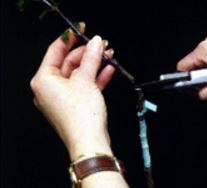| Clonal Propagated Crops |

|
|
1 - About PGRU
2 - Vegetable Seed Crops: 3 - Clonal Propagated Crops 4 - National Apple Rootstock Breeding Program |

 |
Preservation of genetic diversity is the driving factor behind why germplasm repositories exist. The Malus collection is maintained on a 50-acre farm located one mile north of Geneva. Typically, two trees are maintained for each accession. Some accessions are also stored as cryogenically preserved buds. Over time, more and more of the Malus collection will be stored in this manner, in addition to it being preserved as orchard-grown plants.
"The Big Apple Family": This mp3 file (24 MB) contains an interview with Phillip Forsline by Jean Feraca of Radio Without Borders (hereonearth.org), a live global cultural affairs call-in program at Wisconsin Public Radio. Phil was interviewed for nearly an hour about his work to increase the diversity of apple germplasm in the USDA National Plant Germplasm Collection through his apple collections made to Central Asia, China, Russia and Turkey from 1993-1999 with international teams of scientists. He discussed why these collections are important and what is being done by the Plant Genetic Resources Unit in characterizing that apple germplasm here on site and with multiple collaborators world-wide. He also answered questions about apple germplasm from individuals that called in during the program.
Standard preservation of germplasm collections for many perennial crops is very costly and labor-intensive. The PGRU maintains three clonally propagated crops: apple, cold hardy grape, and tart cherry. There are typically two clones maintained for each accession in the Unit's vineyard and orchard. Due to a large number of accessions housed, maintenance costs are very high. In fact, it costs $75 to $100 each year to maintain each whole tree or vine in the field, but only about $1 to preserve it cryogenically. This, coupled with the collection's vulnerability to insect pests, diseases, and natural disasters, suggests that it is no longer prudent and cost effective to maintain the entire genetic diversity of these crops as whole plants.
It is important to note that these three crops are referred to as clonally propagated crops. In all three cases, either a dormant bud or cutting is used to produce a plant identical to the original "mother". Johnny Appleseed has been replaced by bench grafting and budding techniques. Seeds and pollen are still important for breeding programs, but seeds would not be used to grow a Macintosh or Empire tree in your backyard.
 |
 |
 |
Since 1992, 750 accessions have been cryopreserved from the Apple collection at the National Seed Storage Laboratory in Ft. Collins, CO, and an additional 250 have been cryopreserved in Geneva. Buds have been successfully recovered by grafting from over 90% of 600 accessions presently tested. These results, and those from ongoing recovery tests on 400 accessions stored in 1996, indicate cryopreservation may be a safe, cost-effective approach to enhance management of germplasm collections.
|
|
|
Twenty Years of Apple/Grape/Cherry Germplasm Management (MS PowerPoint 8.37 MB) |
| << Previous 1 2 [3] 4 Next >> |




